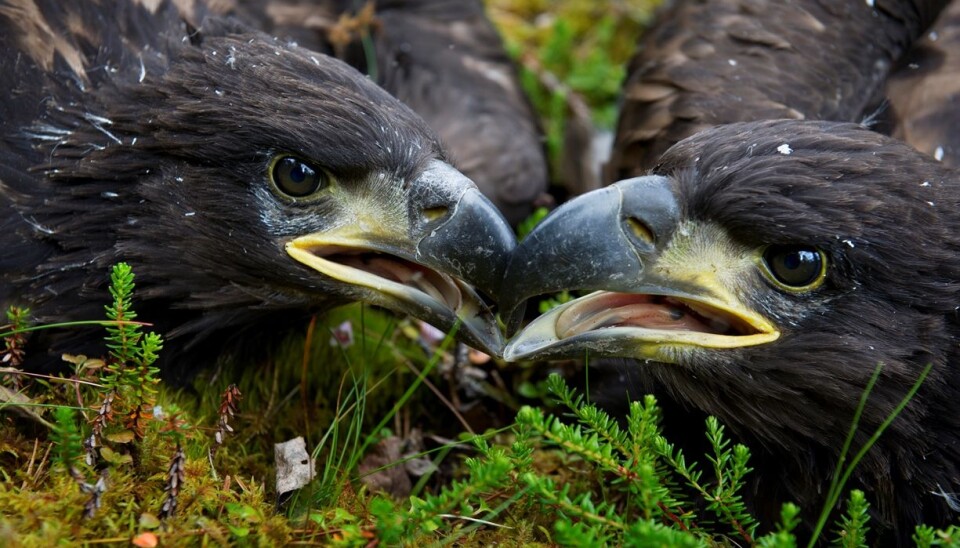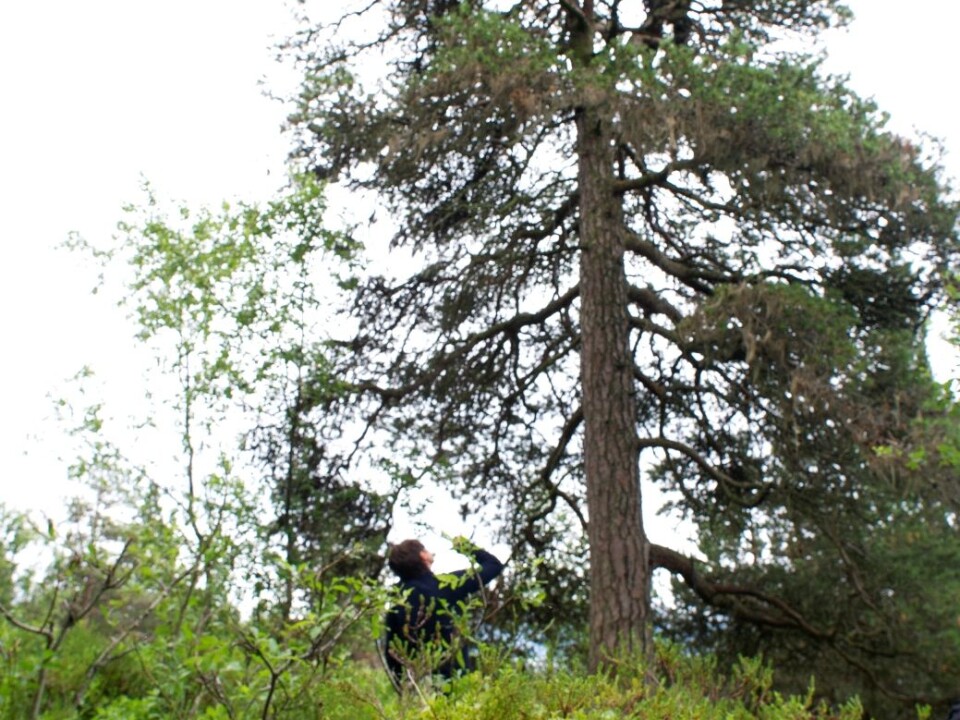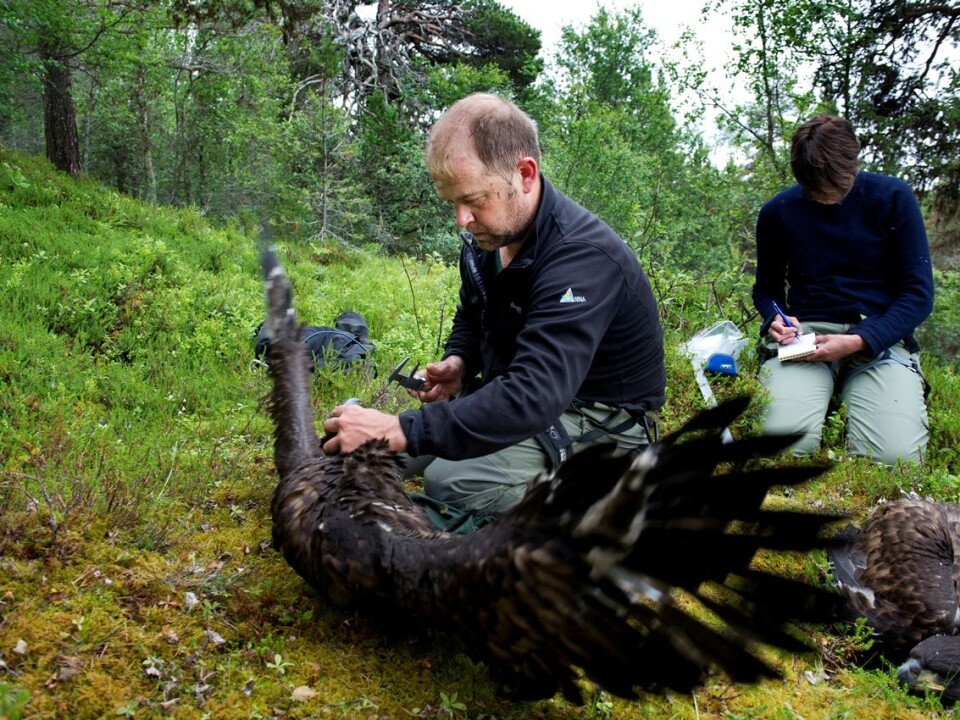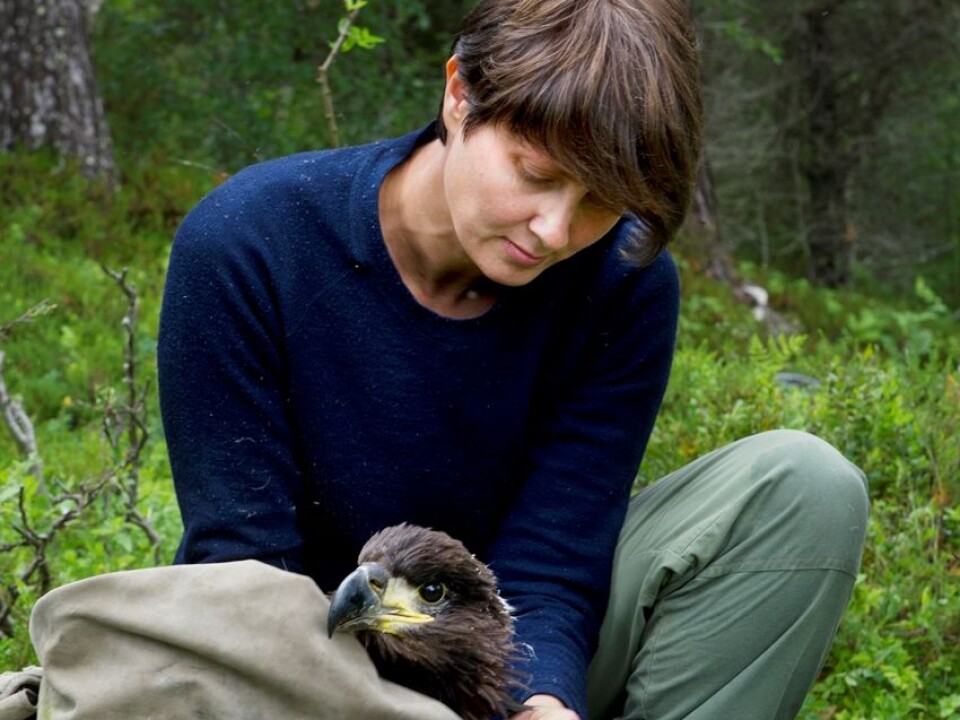An article from University of Tromsø – The Arctic University of Norway

In the eagle’s eyrie
Not everyone willingly participates in research projects. Some actually fight it beak and claw.
Denne artikkelen er over ti år gammel og kan inneholde utdatert informasjon.
The dry branches creak ominously as Trond Johnsen from the Norwegian Institute for Nature Research (NINA) climbs into the six-metre-high coastal pine.
Master’s student Silja Sletten from the Department of Arctic and Marine Biology at UiT protects her colleague as best she can with ropes and other climbing equipment, but it still looks risky. It doesn’t help that the goal of climb is a large eagle’s nest in the top of the tree, where an irritated young white-tailed eagle looks out over the edge.
Above us circle worried eagle parents, periodically screeching out warnings to the intruders.
“We’ve been up in quite a few eagle nests in recent years, but have never had an eagle parent attack us,” says Johnsen reassuringly on our trip through the woods to find the nest.

“They probably realise that people can be dangerous, and their top priority is to stay alive. But they won’t hesitate to attack a fox, for example, if it tries approach their young.”
Old nests
Up in the nest, a young eagle is looking down at the unfamiliar man getting closer. Even from the bottom of the hill, it is clear that we’re not talking about small birds here. By early July, the young birds are only one to two weeks from being able to fly, and not far from being as large as adult eagles.
“There are actually two young up here! A male and a female, I think,” Johnsen shouts.
Down on the ground, Sletten cheers. Two young birds means that this is a good day and well worth the trip.

“The first five nests we visited this year were a waste of time. Two were empty, two others contained abandoned eggs and the eggs in one had fallen out of the nest and were destroyed. Good examples of bad days,” says Sletten.
Eagles mate for life and typically build a number of nests over the years that they can choose from. If a nest is covered in snow and ice when they begin nesting in April, they settle in one of the other, more protected nests.
“White-tailed eagles can get up to 30 years-old, so some of the nests can be really old, I am sure that this nest is ancient,” says Johnsen.
The hunt for pollutants
We are located on South Senja, in a beautiful and bewitching coastal pine forest. The eagles have chosen an idyllic spot among twisted pine trees and heather, and with spectacular views of the fjord.

This is the eighteenth nest the researchers have visited during a hectic summer season in conjunction with the RAPTOR 2015 research project. The project is attempting to identify the impact of pollutants on birds of prey, including on their reproduction abilities. This means taking feather and blood samples from the younger generation of eagles.
When the project started in 2008, samples were collected from several species of raptors. But eventually the decision was made to concentrate on the white-tailed eagle, since the species is relatively easy to deal with.
“Ouch! They’re angry,” shouts Johnsen from the edge of the nest. He is in the process of putting one of the young eagles into a roomy bag that will be hoisted down from the tree, and gets painful proof that even though the bird’s wings are not yet fully developed, its beak and claws are fully functional, thank you very much.
Once down on the ground, the young are weighed and scientists measure their beaks, feet, tail feathers and wingspan. The purpose is to collect material that can be used to follow the development and variation in the birds, and to determine the gender of the young. White-tailed eagle females can be as much as 15 per cent larger than males, and weigh up to 25 per cent more. It is most often the mother eagles that make the most commotion when Sletten and Johnsen come to visit.
“White-tailed eagles are quite dedicated parents. They lay their eggs as early as April, in flat nests in treetops, or on slopes or cliffs. For more than 40 days, they have to sit on the eggs and incubate them, in snowstorms and pouring rain,” says Johnsen.
White-tailed eagles can lay up to three eggs, depending on the quality of the resources they have access to. Sometimes there may be as much as a week between the first and the last egg, which can result in large size differences between siblings.
Sletten plucks out a few breast feathers from each of the young and takes blood samples from a vein in their wings. It is this material that is used to determine what kinds of pollutants the birds have in their bodies, and how much the young eagles have been exposed to so far.
Not big hunters
This is the second year in a row that Sletten has worked as an assistant. Last year’s tests form the basis of her master’s research in which she’s looking at whether there is any correlation between the amount of pollutants in a bird and stress variables (including stress hormones) in eagle individuals.
“We see a lot of old pollutants that are not used anymore, but that are still found in the environment,” says Sletten.
“We find the old classics such as DDT and PCBs, but also pollutants that are still used today, including some flame retardants,” says Johnsen.
Environmental pollutants accumulate in the food chain, so it is often species at the top of the chain that have the greatest exposure. White-tailed eagles are among these species, and ingest contaminants via the foods they eat. An inspection of the nest shows that the young eagles have had a relatively varied diet. Johnsen picks up the remainders of flounder, a wolf fish, a hare and a medium-sized bird.
“In contrast to golden eagles, white-tailed eagles are not particularly dedicated hunters. They are equally satisfied with eating carrion. If they get the opportunity, they will steal prey from other predators, such as the otter,” says Johnsen.
Although eagles do not have a particularly big impact on livestock, they were previously seen as a pest and a potential competitor. There was large-scale hunting of these birds and the population began to decline in earnest in the late 1800s. They were shot, nests were plundered, they were poisoned, and Norway had a bounty on eagles until the early 1960s. The increasing emissions of pollutants also had an impact on the population over the course of the last century. As the century wore on, the future looked bleak for Norway’s largest bird of prey.
Conservation success
In 1968, white-tailed eagles were awarded total protection. Eagles do not have very many young each year, so there was little evidence that the preservation effort did much good in the early years, but eventually the population began to expand.
The white-tailed eagle has now been established in areas where it had previously been completely wiped out, and was removed from the Norwegian Red List of endangered species in 2007. It is estimated that the Norwegian population is at about 3,600 pairs, which accounts for over 50 per cent of the total European population. Populations are also increasing in other parts of Western Europe, partly with the help of Norwegian birds that have been moved to other areas, such as Scotland.
Environmental pollutants remain a threat to eagles, however. The annoyed white-tailed eagle young that are sitting on the ground may not realise that they have contributed to a major research project for their own good, but they will soon be able to enjoy the end of their afternoon’s trial.
Sletten packs the young eagles gently back into the bag, which is then hauled up the tree again. Soon both young birds are safely back in the nest, and we can pack up and leave them in peace.
“White-tailed eagles have very well developed vision and hearing, but not a very good sense of smell. Thus, it is not true that a ‘human smell’ will scare parents away from returning to the nest,” explains Johnsen.
The next step is the laboratory analysis of blood and feathers. Johnsen and Sletten will try to get samples from a couple more young birds before the season is over, but they’re short on time.
“We have maybe one week before this year’s chicks are fledged and we have to throw in the towel for now. This is an incredibly hectic time of year, and it is almost impossible to plan. It’s the same thing every year,” Johnsen mutters, unable to hide his love for this particular part of the job.
“I tend to pat them a little extra now at the end of the season, since I know it will be a long time until I get to be so close to these magnificent birds again,” smiles Sletten as we walk through the woods back to the car.
And when you have seen these amazing birds up close, it’s not so hard to understand the fascination.

































